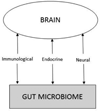The Infant Microbiome: Implications for Infant Health and Neurocognitive Development
- PMID: 26657483
- PMCID: PMC4681407
- DOI: 10.1097/NNR.0000000000000133
The Infant Microbiome: Implications for Infant Health and Neurocognitive Development
Abstract
Background: Beginning at birth, the microbes in the gut perform essential duties related to the digestion and metabolism of food, the development and activation of the immune system, and the production of neurotransmitters that affect behavior and cognitive function.
Objectives: The objectives of this review are to (a) provide a brief overview of the microbiome and the "microbiome-gut-brain axis"; (b) discuss factors known to affect the composition of the infant microbiome: mode of delivery, antibiotic exposure, and infant-feeding patterns; and (c) present research priorities for nursing science and clinical implications for infant health and neurocognitive development.
Discussion: The gut microbiome influences immunological, endocrine, and neural pathways and plays an important role in infant development. Several factors influence colonization of the infant gut microbiome. Different microbial colonization patterns are associated with vaginal versus surgical birth, exposure to antibiotics, and infant-feeding patterns. Because of extensive physiological influence, infant microbial colonization patterns have the potential to impact physical and neurocognitive development and life course disease risk. Understanding these influences will inform newborn care and parental education.
Conflict of interest statement
The authors have no conflicts of interest to report.
Figures
References
-
- Adams MR, Hall CJ. Growth inhibition of food-borne pathogens by lactic and acetic acids and their mixtures. International Journal of Food Science & Technology. 1988;23:287–292.
-
- Adlerberth I, Wold AE. Establishment of the gut microbiota in Western infants. Acta Pædiatrica. 2009;98:229–238. - PubMed
-
- Aloisio I, Mazzola G, Corvaglia LT, Tonti G, Faldella G, Biavati B, Di Gioia D. Influence of intrapartum antibiotic prophylaxis against group B Streptococcus on the early newborn gut composition and evaluation of the anti-Streptococcus activity of Bifidobacterium strains. Applied Microbiology and Biotechnology. 2014;98:6051–6060. - PubMed
Publication types
MeSH terms
Substances
Grants and funding
LinkOut - more resources
Full Text Sources
Other Literature Sources
Medical




